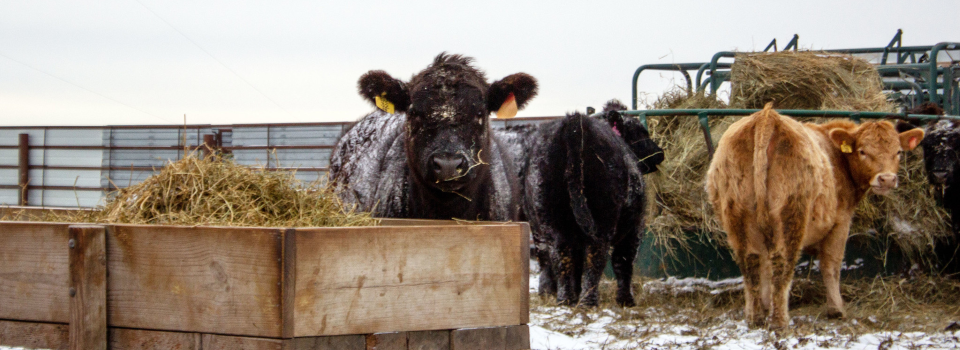
Hay waste typically occurs in open-bottom feeders within the first 24 hours of that bale being open, says K-State beef production specialist Emma Briggs. | Download photo
Certain hay feeders improve profitability
K-State beef specialist outlines three commonly used kinds
At a glance: Kansas State University beef production specialist Emma Briggs discusses the advantages and disadvantages of three kinds of hay feeders, noting that some do a better job of limiting waste and boosting an operation’s profitability.
More information: Emma Briggs, 785-625-3425, eabrigss@ksu.edu
Related: Agriculture Today
Jan. 29, 2025
By Jacob Klaudt, K-State Research and Extension news service
MANHATTAN, Kan. – It’s inevitable; winter weather always leads to cattle producers feeding their livestock supplemental forage, something that can be quite costly depending on the hay’s quality and availability.
Kansas State University beef production specialist Emma Briggs said choosing the right hay feeder will help reduce the waste of this valuable input and improve an operation’s efficiency and profitability, “especially in Kansas.”
“Everyone has different needs,” she said. “But how you feed your hay can significantly impact how much forage you feed during the winter, as well as how much can get wasted due to trampling or other environmental factors.”
Briggs sees many ranchers using open-bottom hay rings, which are typically light and easy to move around from place to place. However, their circular design and unobstructed foundation contribute to a large portion of hay never making it past an animal’s mouth.
“Open-bottom feeders make it easy for cattle to pull the hay out and increase waste,” she said. “Research shows that 16-21% of that original bale weight can get wasted with them due to cattle trampling the hay. This type of waste can add up very quickly.”
Yet, this does not mean an entirely new hay ring has to be purchased. Ranchers can modify their existing ones to become sheet-bottom feeders by welding a 16-18 inch tall piece of sheet metal to the base of their open feeders.
“These help in the later stages of feeding when that bale starts to collapse, and it helps maintain the feeding area by keeping it clean and making sure that the loose hay stays within reach of the cattle and in the feeders,” Briggs said.
She added: “Researchers have seen about a 39% reduction in hay squandering compared to the open-bottom design. Some studies say that only around 12% of the original bale weight gets misused.”
If the cost of a new feed container is not an issue, purchasing a cone or basket feeder may be the best choice to minimize unnecessary hay loss.
“Those (feeders) either keep the bale suspended or help keep the upper third of the bale restricted in more of an upright position, so it doesn't explode and go everywhere within the feeder,” Briggs said. “It holds it more tightly, and so we've seen hay waste as little as 2-5% of the total weight in some cases.”
Unfortunately, cone and basket feeders weigh a lot, which makes it difficult for producers to transport them. Additionally, freshly weaned calves may have issues reaching into these feeders, leaving the bale's core unused.
According to Briggs, it may be more beneficial for some ranchers to unroll their bales instead of using a hay ring. This feeding strategy doesn’t afford continual access to feed like sheet-bottom feeders.
“If you have the land and the resources to do so, unrolling hay can be a good option,” she said. “But you need to ensure that you're only unrolling enough to where the cattle can clean up everything that you provide within the first 12 hours, or else that will likely get converted to bedding.”
***

K‑State Research and Extension is a short name for the Kansas State University Agricultural Experiment Station and Cooperative Extension Service, a program designed to generate and distribute useful knowledge for the well‑being of Kansans. Supported by county, state, federal and private funds, the program has county extension offices, experiment fields, area extension offices and regional research centers statewide. Its headquarters is on the K‑State campus in Manhattan. For more information, visit www.ksre.ksu.edu. K-State Research and Extension is an equal opportunity provider and employer.